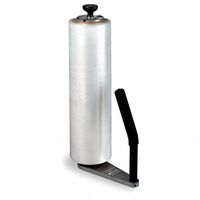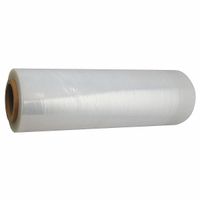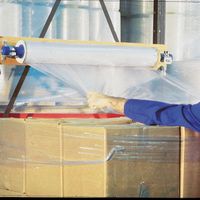Call +(254) 703 030 000 / 751 483 999 / 721 704 777
- Home
- Packaging Shipping
- Stretch Wrap
.....Read More
Frequently Asked Questions
What is stretch wrap used for?
Stretch wrap, also known as stretch film, is a highly stretchable plastic film commonly used for packaging and securing products. Its primary function is to hold items together on a pallet for storage and transportation. The film is wrapped around the items, and its elasticity ensures that the load is tightly bound, preventing movement and potential damage during transit.
Stretch wrap serves several purposes:
1. **Stability and Security**: It stabilizes products on pallets, reducing the risk of shifting, tipping, or falling during handling and transport. This is crucial for maintaining the integrity of the load and ensuring safety.
2. **Protection**: It provides a protective barrier against dust, dirt, moisture, and other environmental factors. This is particularly important for products that are sensitive to such elements.
3. **Cost-Effectiveness**: Stretch wrap is a cost-effective packaging solution. It is relatively inexpensive compared to other packaging materials and methods, and its application requires minimal equipment.
4. **Versatility**: It can be used for a wide range of products, from small boxes to large industrial equipment. Different types of stretch wrap, such as hand stretch film, machine stretch film, and specialty films, cater to various needs and applications.
5. **Tamper Evidence**: Stretch wrap can serve as a deterrent against tampering. If the wrap is disturbed, it is usually evident, alerting handlers to potential issues.
6. **Efficiency**: The use of stretch wrap can streamline the packaging process, making it quicker and more efficient, especially when using automated wrapping machines.
Overall, stretch wrap is an essential tool in logistics and supply chain management, ensuring that products are securely packaged and protected throughout their journey.
How does stretch wrap protect pallets?
Stretch wrap protects pallets by providing several key benefits:
1. **Stability and Security**: Stretch wrap tightly binds the items on a pallet, preventing them from shifting during transportation. This stability reduces the risk of damage caused by movement, ensuring that products remain intact from the warehouse to their final destination.
2. **Protection from Contaminants**: The wrap acts as a barrier against dust, dirt, and moisture, which can damage products. This is particularly important for goods that are sensitive to environmental conditions, such as food items or electronics.
3. **Tamper Evidence**: Stretch wrap can serve as a deterrent against tampering. If the wrap is disturbed or removed, it is immediately noticeable, alerting handlers to potential issues. This is crucial for maintaining the integrity of products, especially in industries where security is a concern.
4. **Cost-Effectiveness**: Compared to other packaging methods, stretch wrap is relatively inexpensive. It requires minimal equipment and can be applied quickly, reducing labor costs and increasing efficiency in packaging operations.
5. **Versatility**: Stretch wrap can accommodate various shapes and sizes of pallet loads. It can be applied manually or with machines, making it adaptable to different operational scales and requirements.
6. **Load Containment**: The elasticity of stretch wrap allows it to conform to the shape of the load, providing a snug fit that holds items together. This containment is crucial for preventing load collapse during handling and transit.
7. **Visibility**: Clear stretch wrap allows for easy identification of products without removing the wrap, facilitating inventory management and reducing the need for additional labeling.
Overall, stretch wrap is an essential tool in logistics and supply chain management, offering a combination of protection, efficiency, and cost savings.
What are the benefits of using stretch wrap?
Stretch wrap, also known as stretch film, offers several benefits for packaging and shipping:
1. **Protection**: Stretch wrap provides a protective barrier against dust, dirt, moisture, and other environmental factors, ensuring that products remain clean and dry during transit and storage.
2. **Stability**: It secures items tightly together on a pallet, reducing the risk of shifting, tipping, or falling during transportation. This stability minimizes product damage and loss.
3. **Cost-Effectiveness**: Stretch wrap is relatively inexpensive compared to other packaging materials. It requires minimal equipment for application, reducing overall packaging costs.
4. **Versatility**: Available in various thicknesses and types, stretch wrap can be used for a wide range of products, from small boxes to large industrial equipment. It can accommodate irregularly shaped items as well.
5. **Efficiency**: Stretch wrap is quick and easy to apply, either manually or with a machine, speeding up the packaging process and improving operational efficiency.
6. **Visibility**: Being transparent, stretch wrap allows for easy identification of products without the need to unwrap, facilitating inventory management and reducing handling time.
7. **Security**: It can deter tampering and theft by making it evident if the wrap has been disturbed. Colored or opaque films can also be used to conceal valuable items.
8. **Eco-Friendly Options**: Many stretch wraps are recyclable, and some are made from biodegradable materials, offering environmentally friendly packaging solutions.
9. **Load Containment**: It provides excellent load containment, ensuring that products remain tightly packed and secure, which is crucial for long-distance shipping.
10. **Customization**: Stretch wrap can be customized with branding or instructions, enhancing brand visibility and providing important handling information.
Overall, stretch wrap is a versatile, cost-effective, and efficient packaging solution that enhances product protection and stability during storage and transportation.
How do you apply stretch wrap to a pallet?
1. **Preparation**: Ensure the pallet is stable and the load is evenly distributed. Place the heaviest items at the bottom and lighter ones on top. Make sure there are no sharp edges that could tear the wrap.
2. **Choose the Right Wrap**: Select the appropriate stretch wrap based on the load's weight and size. Common types include hand stretch wrap and machine stretch wrap.
3. **Start at the Base**: Begin by tying the stretch wrap to a corner of the pallet base. This can be done by twisting the wrap into a rope and tucking it under a corner or by using a knot.
4. **Wrap the Base**: Walk around the pallet, wrapping the base 2-3 times to secure the load to the pallet. Keep the wrap taut to ensure stability.
5. **Move Upward**: Gradually work your way up the pallet, overlapping each layer by about 50%. Maintain tension to keep the wrap tight.
6. **Secure the Top**: Once you reach the top, wrap it 2-3 times to secure the load. If the load is taller, consider using a ladder or a stretch wrap dispenser with an extended handle.
7. **Reinforce**: For added stability, make another pass from top to bottom, ensuring all layers are tightly secured.
8. **Finish**: Cut the wrap and press the end against the wrapped pallet to secure it. Some wraps have a self-adhesive feature that helps it stick.
9. **Check Stability**: Gently push the pallet to ensure the load is stable and the wrap is secure. Adjust if necessary.
10. **Label**: If required, label the pallet for identification and handling instructions.
What is the difference between stretch wrap and shrink wrap?
Stretch wrap and shrink wrap are both packaging materials used to secure and protect products, but they differ in application and properties.
Stretch wrap, also known as stretch film, is a highly stretchable plastic film, typically made from linear low-density polyethylene (LLDPE). It is wrapped around items, and its elasticity holds the items tightly together. The film is applied by stretching it around the products, either manually or using a machine. Stretch wrap is commonly used for palletizing goods, providing stability during transportation and storage. It is advantageous for its flexibility, ease of use, and ability to conform to various shapes.
Shrink wrap, on the other hand, is a plastic film that shrinks tightly over whatever it is covering when heat is applied. It is usually made from polyolefin, PVC, or polyethylene. The process involves wrapping the film loosely around the item and then applying heat using a heat gun or shrink tunnel, causing the film to shrink and conform to the shape of the product. Shrink wrap is often used for packaging individual items or bundling multiple products together, offering a tamper-evident seal and protection from dust and moisture.
In summary, the primary difference lies in their application methods: stretch wrap is applied by stretching, while shrink wrap requires heat to shrink. Stretch wrap is ideal for securing and stabilizing loads, whereas shrink wrap is better suited for providing a tight, protective seal around individual or grouped items.
Can stretch wrap be recycled?
Yes, stretch wrap can be recycled, but the process and feasibility depend on several factors. Stretch wrap, commonly made from linear low-density polyethylene (LLDPE), is a type of plastic film used for securing products on pallets. Its recyclability is influenced by the type of material, the presence of contaminants, and local recycling capabilities.
To recycle stretch wrap, it must be clean and free from contaminants like labels, dirt, or other materials. Contaminated wrap can complicate the recycling process and reduce the quality of the recycled product. Many recycling facilities accept stretch wrap, but it's essential to check with local programs as capabilities vary.
The recycling process involves collecting, cleaning, and shredding the wrap into small pellets. These pellets can then be used to manufacture new products, such as plastic bags, composite lumber, or new stretch wrap. Some companies offer take-back programs specifically for stretch wrap, ensuring it is properly recycled.
However, not all curbside recycling programs accept stretch wrap due to its tendency to tangle in sorting machinery. Instead, it is often collected through designated drop-off locations or specialized recycling programs. Businesses that generate large quantities of stretch wrap may work directly with recyclers to ensure efficient processing.
In summary, while stretch wrap is recyclable, successful recycling requires clean material and access to appropriate facilities. Individuals and businesses should verify local recycling options and adhere to guidelines to ensure effective recycling of stretch wrap.
What types of stretch wrap are available?
There are several types of stretch wrap available, each designed for specific applications and requirements:
1. **Hand Stretch Wrap**: Used for manual wrapping, this type is ideal for smaller operations or low-volume applications. It is available in various thicknesses and widths, allowing for flexibility in wrapping different sizes of loads.
2. **Machine Stretch Wrap**: Designed for use with stretch wrap machines, this type is suitable for high-volume applications. It ensures consistent application and is available in different grades, such as cast and blown film.
3. **Cast Stretch Wrap**: Made using a cast extrusion process, this wrap is clear, glossy, and quiet when unwound. It offers excellent clarity for barcode scanning and is cost-effective for high-volume use.
4. **Blown Stretch Wrap**: Produced through a blown extrusion process, this wrap is more robust and offers superior puncture resistance. It is ideal for irregular loads and provides better cling, though it is noisier and more expensive than cast wrap.
5. **Pre-Stretched Wrap**: This wrap is stretched during manufacturing, reducing the effort required during application. It is lightweight, cost-effective, and provides excellent load stability.
6. **Colored Stretch Wrap**: Available in various colors, this wrap is used for inventory control, product identification, or to conceal load contents. It offers the same protection as clear wrap but with added benefits for organization.
7. **UVI Stretch Wrap**: Contains ultraviolet inhibitors, making it suitable for outdoor storage by protecting against UV rays. It prevents degradation and maintains load integrity under sunlight exposure.
8. **Vented Stretch Wrap**: Features perforations or holes, allowing air circulation. It is ideal for products that need to breathe, such as fresh produce or hot items that need to cool down.
9. **Specialty Stretch Wrap**: Includes anti-static wrap for electronic components and reinforced wrap for heavy or sharp-edged loads, providing additional protection and stability.
How do stretch wrap machines work?
Stretch wrap machines automate the process of applying stretch film to secure and protect products on pallets. They work by using a combination of mechanical and electronic components to wrap the film tightly around the items. Here's a breakdown of how they operate:
1. **Loading the Pallet**: The pallet with products is placed on the turntable or conveyor of the machine. In some models, the operator manually positions the pallet, while in others, it is automatically fed into the machine.
2. **Film Attachment**: The stretch film is attached to the pallet or the product. This can be done manually by the operator or automatically by the machine, depending on the model.
3. **Wrapping Process**:
- **Turntable Machines**: The turntable rotates the pallet while the film carriage moves up and down, wrapping the film around the pallet. The tension and speed can be adjusted to ensure a tight wrap.
- **Rotary Arm Machines**: The pallet remains stationary while a rotary arm moves around it, wrapping the film. This is ideal for unstable or lightweight loads.
- **Orbital Wrappers**: The film is applied as the product passes through a rotating ring, suitable for long or oddly shaped items.
4. **Film Tension and Pre-Stretch**: The machine stretches the film before applying it, which increases its strength and reduces film usage. Tension settings can be adjusted to accommodate different load types.
5. **Film Cutting and Sealing**: Once the wrapping is complete, the machine cuts the film and seals the end to prevent unraveling. This can be done using a hot wire or a mechanical cutter.
6. **Unloading**: The wrapped pallet is removed from the machine, either manually or automatically, ready for storage or shipment.
These machines enhance efficiency, reduce labor costs, and ensure consistent wrapping quality.
What is the purpose of top sheeting in pallet wrapping?
Top sheeting in pallet wrapping serves several important purposes, primarily aimed at protecting the goods during storage and transportation.
1. **Protection from Environmental Elements**: Top sheeting acts as a barrier against dust, dirt, moisture, and other environmental contaminants. This is particularly crucial for products that are sensitive to water or dust, such as electronics, food items, or pharmaceuticals.
2. **Weather Resistance**: In outdoor storage or during transportation, pallets may be exposed to rain, snow, or sunlight. Top sheeting provides an additional layer of protection against these weather conditions, helping to prevent damage to the goods.
3. **Load Stability**: By covering the top of the pallet, top sheeting can contribute to the overall stability of the load. It helps to keep the items in place, reducing the risk of shifting during transit, which can lead to damage or accidents.
4. **Cost-Effectiveness**: Using top sheeting can be a cost-effective way to protect goods compared to other methods like using rigid covers or additional packaging materials. It is relatively inexpensive and easy to apply.
5. **Versatility**: Top sheeting can be used with various types of pallet wrapping, including stretch wrap and shrink wrap. It is adaptable to different sizes and shapes of loads, making it a versatile solution for many industries.
6. **Enhanced Security**: By covering the top of the pallet, top sheeting can also deter tampering and theft. It makes it more difficult for unauthorized individuals to access the goods without detection.
Overall, top sheeting is a practical and efficient solution for enhancing the protection and security of palletized goods, ensuring they reach their destination in optimal condition.
How do you choose the right stretch wrap for your needs?
To choose the right stretch wrap, consider the following factors:
1. **Type of Load**: Determine if your load is uniform, irregular, or fragile. Uniform loads can use standard stretch wrap, while irregular or fragile loads may require specialty wraps like vented or reinforced options.
2. **Weight of Load**: Heavier loads need thicker, more durable wraps. Gauge thickness ranges from 37 to 150+ gauge; heavier loads typically require 80 gauge or higher.
3. **Stretch Wrap Type**: Decide between hand stretch wrap and machine stretch wrap. Hand wraps are suitable for low-volume operations, while machine wraps are ideal for high-volume, consistent applications.
4. **Material**: Choose between cast and blown stretch wrap. Cast stretch wrap is clear, quiet, and offers consistent thickness, while blown stretch wrap is more puncture-resistant and has higher cling properties.
5. **Environmental Conditions**: Consider temperature and humidity. Blown stretch wrap performs better in cold or outdoor environments due to its superior puncture resistance.
6. **Cling and Clarity**: If product visibility is important, opt for clear cast wrap. For loads requiring more secure containment, blown wrap with higher cling properties is preferable.
7. **Cost**: Balance cost with performance needs. Thinner wraps may be cheaper but could compromise load stability, leading to potential damage and higher costs in the long run.
8. **Sustainability**: Consider eco-friendly options like biodegradable or recyclable wraps if sustainability is a priority.
9. **Supplier Support**: Choose a supplier that offers technical support and guidance to ensure you select the most suitable wrap for your specific needs.
By evaluating these factors, you can select a stretch wrap that ensures load stability, protection, and cost-effectiveness.




